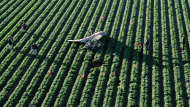
U.S. Customs and Border Patrol is spending big - just under $100 million - to combat drug smugglers who use small aircraft worth only a few thousand dollars each to ferry narcotics into the U.S.
Last week the CBP awarded SRCTec, a New York-based research and development company, a $99,955,087.00 contract for a real-time detection system that is specifically designed to pick out ultralight aircrafts, slow-speed rudimentary manned planes that have a very small radar signature, on America's southern border.
The contract award ended a year-long search for a way to spot ultralights loaded with narcotics - a tactic lawmakers said is being employed more and more in recent years by drug smugglers hoping to buzz back and forth over border fences undetected. Ultralights are easy-to-use aircraft - often little more than an airframe and engine - that can be bought online or constructed at home from kits for a few thousand dollars. Ultralights do not require a pilot's license.
In May 2011, The Los Angeles Times reported that in the previous fiscal year, ultralights - sometimes with armed pilots - had entered U.S. borders illegally at least 228 times, double the number compared to the year before that.
One man died in 2008 when his ultralight crashed into a lettuce field in Arizona, according to the CBP. Nearly 150 lbs. of marijuana was found with the downed aircraft. A year later CBP managed to spot an ultralight using their current radar and followed it to its own crash elsewhere in Arizona. In that case,CBP said the pilot managed to escape but two others believed to be involved were arrested and another 275 lbs. of pot was confiscated - worth an estimated $220,000 on the street.
In 2010, the military reported two F-16s had been scrambled by NORAD to chase down an ultralight near the Arizona border. The fighter jets - capable of flying 1,500 miles per hour - reportedly shadowed the ultralight - which generally has a top speed around 60 miles per hour - for 30 minutes before the ultralight decided to head back into Mexican airspace.
The ultralight's use by smugglers has become so ubiquitous that Congress recently updated their definition of "aircraft" to include ultralights and, therefore, make those caught smuggling drugs with them subject to the same penalties as other aircraft under the Tariff Act of 1930. The legislation, known as the Ultralight Aircraft Smuggling Prevention Act of 2012, was the last bill sponsored by Rep. Gabrielle Giffords (D-Arizona) before she resigned from Congress after surviving an apparent assassination attempt last January.
"The use of ultralight vehicles is yet another example of the extreme measures drug smugglers will use to get drugs into the United States," Sen. Dianne Feinstein (D-California), Chairman of the Senate Caucus on International Narcotics Control, said after the bill passed the Senate.
Ultralights were also feared to have been part of an alleged terror plot uncovered in Spain earlier this month. In that case, three men were arrested before the plot could get off the ground. Authorities said two of them had been practicing flying ultralights and small drones.
The CBP contract winner, SRC Tec, lists what it calls the VantagePoint system under its products. According to the company's website, VantagePoint can "detect and track people, vehicles, and low and slow aircraft, such as [unmanned aircraft systems] and ultralights."


